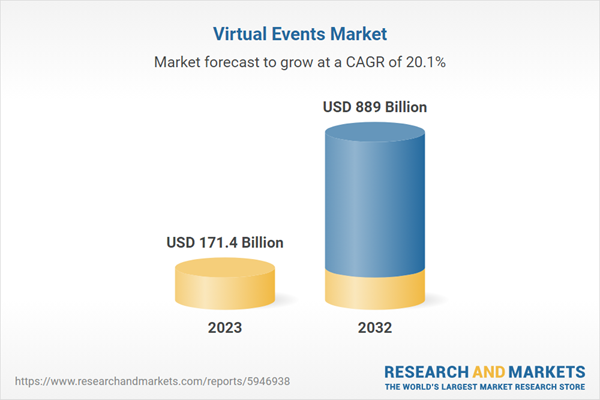The global virtual events market size reached US$ 171.4 Billion in 2023. Looking forward, the publisher expects the market to reach US$ 889.0 Billion by 2032, exhibiting a growth rate (CAGR) of 20.1% during 2023-2032. The increasing number of smartphone users around the world, emergence of various advanced technologies, and rising adoption among companies to build brand image and engage more customers represent some of the key factors driving the market.
Rising Demand for Convenient Meetings Augmenting Market Growth
The growing adoption of virtual events due to the increasing demand for convenient meetings among individuals currently represents one of the primary drivers influencing the market positively. Moreover, there is a rise in the demand for flexible, time-saving, and cost-effective business meeting solutions among various organizations across the globe. This, coupled with the increasing utilization of virtual events to provide high-quality interactive sessions and build enhanced brand awareness, is strengthening the growth of the market.
What are Virtual Events?
Virtual events, also known as online events, provide virtual interaction at different locations through various connected devices, such as smartphones, laptops, desktop computers, and tablets. They offer flexibility and scalability at remote locations and allow real-time language translation in different languages. They assist in maximizing greater reach to a wide audience while reducing the cost of the event. They also aid in enhanced data tracking of attendees, improving accessibility, generating more revenue in a business, and enhancing the brand image of a company. Besides this, they are beneficial for building trust among customers, increasing business sales, and reducing traveling costs. As they are widely utilized to efficiently conduct webinars, live streams, trade shows, online classes, product launches, corporate meetings, and online tours, the demand for virtual events is rising across the globe.
Virtual Events Market Trends:
At present, the rising utilization of virtual events among companies, as they effectively manage time and resources compared to physical events, represents one of the key factors contributing to the growth of the market. Besides this, the growing adoption of virtual events, as they are highly interactive, friendly, and provide live chat and download options during meetings, is offering a positive market outlook. Additionally, there is a rise in the demand for flexible and remote workplaces for organizing business procedures among employees around the world. This, coupled with the increasing employment of virtual events due to a shifting focus on enhancing and building brand loyalty and engaging more customers, is bolstering the growth of the market. Apart from this, the rising adoption of virtual events among enterprises for content and social media management and event marketing across the globe is impelling the growth of the market. Moreover, the increasing emergence of advanced technologies, such as artificial intelligence (AI), augmented reality (AR), and virtual reality (VR), that allow enhanced online communication around the world is offering lucrative growth opportunities to industry investors. In addition, the rapid digitalization, along with the increasing number of smartphone users worldwide, is supporting the growth of the market. Furthermore, key players are introducing enhanced virtual conference and networking solutions for improved customer experience, which is strengthening the growth of the market.
Key Market Segmentation:
The publisher provides an analysis of the key trends in each sub-segment of the global virtual events market report, along with forecasts at the global, regional and country level from 2024-2032. The report has categorized the market based on type, solution type, application and end-use.
Type Insights:
- Video Conferencing and Unified Communications & Collaborations
- Web Conferencing
The report has provided a detailed breakup and analysis of the virtual events market based on the type. This includes video conferencing and unified communications & collaborations, and web conferencing. According to the report, video conferencing and unified communications and collaborations represented the largest segment, as they provide audio and video sharing communication facilities in real-time with enhanced connectivity and productivity. In addition, they assist in streamlining interaction methods between employees and customers while reducing travel and information technology (IT) costs.
Web conferencing is an online service that allows holding live meetings, conferencing, and training. It aids in decreasing commuting time, lowering office costs, and increasing productivity. Besides this, several web conferencing platforms provide a screen sharing feature that enhances learner or user experience and solves problems easily. Moreover, it allows businesses to offer online demos of services and products without wasting time in planning.
Solution Type Insights:
- Webinars and Enterprise Streaming
- Networking and Collaborations
- Content Sharing and Media Development
- Event Marketing
- Others
A detailed breakup and analysis of the virtual events market based on the solution type has also been provided in the report. This includes webinars and enterprise streaming, networking and collaborations, content sharing and media development, event marketing, and others.
Webinars and enterprise streaming assist in generating leads and converting audiences into paying customers. In line with this, it provides real-time engagement to customers and employees without any requirement for a suitable physical place and reduces the operational costs of a business.
Networking and collaborations in virtual events encourage interaction and idea sharing among attendees. Besides this, technological advancements, such as artificial intelligence (AI) and machine learning (ML), in virtual event networking platforms connect the audience with similar interests quickly without wasting time.
Content sharing and media development in virtual events can benefit in generating more revenues for a business. Moreover, creating sharable online content leads to the growth of a business and expands its reach to a wide audience around the world.
Application Insights:
- Virtual Conferences
- Virtual Tradeshows
- Online Education Programs
- Virtual Reality Exhibitions
- Others
A detailed breakup and analysis of the virtual events market based on the application has also been provided in the report. This includes virtual conferences, virtual tradeshows, online education programs, virtual reality exhibitions, and others. Virtual conferences allow participants to access live onsite meetings and events from internet devices remotely. It aids in eliminating logistics involved with in-person events and can include many people in the meetings without any hassle.
Virtual tradeshows are events in which goods and services are exhibited in online mode conveniently. Various organizations display their products and services and provide information that can assist in increasing sales. Moreover, they reduce costs, maximize reach, and create enhanced engagement among audiences across the globe.
Online education programs in virtual mode provide enhanced learning experiences to students around the world. They offer one-on-one training and consulting sessions for those who don't want to share their personal details. In addition, it provides accessibility and an opportunity for students to explore and learn more about educational institutes.
End-Use Insights:
- Corporate
- Education
- Healthcare
- Finance and Banking
- Government
- Others
A detailed breakup and analysis of the virtual events market based on the end-use has also been provided in the report. This includes corporate, education, healthcare, finance and banking, government, and others. According to the report, corporate accounted for the largest market share due to the increasing utilization of virtual events in business and client meetings and promoting new products. In line with this, the rising demand for interactive virtual meeting platforms to coordinate and work efficiently in a company is contributing to the growth of the market.
The education sector is increasingly adopting a virtual mode of learning to provide an enhanced experience to students. The growing utilization of virtual event tools and solutions for training purposes is positively influencing the market. Moreover, rising preferences for online classes among students, as they offer convenience and save time, is propelling the growth of the market.
Healthcare requires virtual conferencing that allows doctors or health professionals to provide consultations to patients through online mode, which assists in saving time. Moreover, the rising utilization of virtual events among healthcare professionals to interact with allied professionals and share their knowledge and experiences is strengthening the growth of the market.
Regional Insights:
- North America
- United States
- Canada
- Asia Pacific
- China
- Japan
- India
- South Korea
- Australia
- Indonesia
- Others
- Europe
- Germany
- France
- United Kingdom
- Italy
- Spain
- Russia
- Others
- Latin America
- Brazil
- Mexico
- Others
- Middle East and Africa
The report has also provided a comprehensive analysis of all the major regional markets, which include North America (the United States and Canada); Asia Pacific (China, Japan, India, South Korea, Australia, Indonesia, and others); Europe (Germany, France, the United Kingdom, Italy, Spain, Russia, and others); Latin America (Brazil, Mexico, and others); and the Middle East and Africa. According to the report, North America (the United States and Canada) was the largest market for virtual events. Some of the factors driving the North America virtual events market included the growing adoption of digitally simulated platforms in the healthcare industry, rising number of multinational companies and increasing demand for business meetings in the government sector. In addition, the rising demand for virtual events, as they are easy to conduct and assist in generating more revenues, is bolstering the growth of the market in the region.
Competitive Landscape:
The report has also provided a comprehensive analysis of the competitive landscape in the global virtual events market. Some of the companies covered in the report include:
- Adobe Inc
- Alcatel-Lucent
- Atlassian
- Avaya Holdings Corp.
- Broadsoft Inc
- Cisco Systems Inc
- Citrix Systems Inc
- Huawei
- International Business Machines
- Microsoft Corporation
- Mitel Networks
- Toshiba Corporation
- Zoom Video Communications Inc
Please note that this only represents a partial list of companies, and the complete list has been provided in the report.
Key Questions Answered in This Report
1. How big is the virtual events market?
2. What is the expected growth rate of the global virtual events market during 2024-2032?
3. What are the key factors driving the global virtual events market?
4. What has been the impact of COVID-19 on the global virtual events market?
5. What is the breakup of the global virtual events market based on the type?
6. What is the breakup of the global virtual events market based on the end use?
7. What are the key regions in the global virtual events market?
8. Who are the key players/companies in the global virtual events market?
Table of Contents
Companies Mentioned
- Adobe Inc.
- Alcatel-Lucent
- Atlassian
- Avaya Holdings Corp.
- Broadsoft Inc.
- Cisco Systems Inc.
- Citrix Systems Inc.
- Huawei
- International Business Machines
- Microsoft Corporation
- Mitel Networks
- Toshiba Corporation
- Zoom Video Communications Inc.
Methodology

LOADING...
Table Information
| Report Attribute | Details |
|---|---|
| No. of Pages | 141 |
| Published | March 2024 |
| Forecast Period | 2023 - 2032 |
| Estimated Market Value ( USD | $ 171.4 Billion |
| Forecasted Market Value ( USD | $ 889 Billion |
| Compound Annual Growth Rate | 20.1% |
| Regions Covered | Global |
| No. of Companies Mentioned | 13 |









